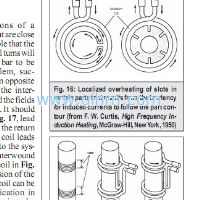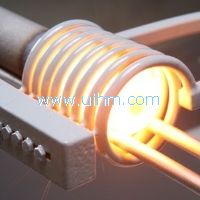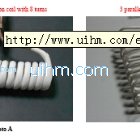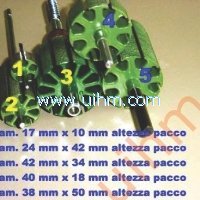High Frequency Induction Heating
2013/4/8 Views
Introduction
Solid state converters for induction heating are built with different types of switches depending on
frequency range: thyristors for frequencies up to about 10 kHz, IGBTs up to about 100 kHz and
PowerMOS up to about 400 kHz. IGBTs have several strengths compared with PowerMOS: better
ruggedness, more power from each module and lower price. However, it is necessary to derate
considerably to reach high frequencies due to much higher switching losses.
An important feature of induction heating converters is their ability to adapt to the variations in the
load. The induction coil is electrically represented by an inductance in series with a resistance. The
inductance requires reactive power and the resistance needs active power. The converter is the source
for the active power and the compensation capacitor for the reactive power. The solid-state converters
have taken over for fixed frequency motor-generator sets and, with the possibility of tuning the output
circuit to its resonance frequency, the balance between production and consumption of reactive power
could be made as an automatic adaptation. This is the standard today.
Load matching
When a metal is heated from room temperature to a suitable temperature for forging, melting, heat
treatment, etc., the resistivity of the metal changes typically by a factor 4 - 5. Steel, with ferromagnetic
properties at low temperature, turns to nonmagnetic behavior above the Curie temperature. In
induction heating processes, the induction coil is often made to cover a certain range in work-piece
dimensions. From the equation describing power transfer to the work piece (ref. [2]), we see that the
load resistance is proportional to the work-piece diameter, and to the square root of work piece
resistivity and relative permeability. Due to saturation effects, the effective relative permeability of
magnetic steel is dependent on the field strength in the coil. This means that the change in load
impedance, when the work piece temperature passes the Curie temperature, is larger at moderate than
at high power densities and larger at high frequency than at low frequency. A consequence of this
characteristic is that the induction heating equipment has to deal with a range in load resistance. For
one coil and work piece, the range is about 1:2 in the non-magnetic case, and sometimes more than 1:4
in case of steel being heated above the Curie temperature, at moderate power density and high
frequency.
A normal approach to this is to equip the system with some means of adjusting load impedance to
the best setting and accept output power below nominal in part of the heat cycle. A different approach
is to equip the inverter with extended capacity to supply higher voltage or higher current than nominal
as illustrated in figure 1.
Solid state converters for induction heating are built with different types of switches depending on
frequency range: thyristors for frequencies up to about 10 kHz, IGBTs up to about 100 kHz and
PowerMOS up to about 400 kHz. IGBTs have several strengths compared with PowerMOS: better
ruggedness, more power from each module and lower price. However, it is necessary to derate
considerably to reach high frequencies due to much higher switching losses.
An important feature of induction heating converters is their ability to adapt to the variations in the
load. The induction coil is electrically represented by an inductance in series with a resistance. The
inductance requires reactive power and the resistance needs active power. The converter is the source
for the active power and the compensation capacitor for the reactive power. The solid-state converters
have taken over for fixed frequency motor-generator sets and, with the possibility of tuning the output
circuit to its resonance frequency, the balance between production and consumption of reactive power
could be made as an automatic adaptation. This is the standard today.
Load matching
When a metal is heated from room temperature to a suitable temperature for forging, melting, heat
treatment, etc., the resistivity of the metal changes typically by a factor 4 - 5. Steel, with ferromagnetic
properties at low temperature, turns to nonmagnetic behavior above the Curie temperature. In
induction heating processes, the induction coil is often made to cover a certain range in work-piece
dimensions. From the equation describing power transfer to the work piece (ref. [2]), we see that the
load resistance is proportional to the work-piece diameter, and to the square root of work piece
resistivity and relative permeability. Due to saturation effects, the effective relative permeability of
magnetic steel is dependent on the field strength in the coil. This means that the change in load
impedance, when the work piece temperature passes the Curie temperature, is larger at moderate than
at high power densities and larger at high frequency than at low frequency. A consequence of this
characteristic is that the induction heating equipment has to deal with a range in load resistance. For
one coil and work piece, the range is about 1:2 in the non-magnetic case, and sometimes more than 1:4
in case of steel being heated above the Curie temperature, at moderate power density and high
frequency.
A normal approach to this is to equip the system with some means of adjusting load impedance to
the best setting and accept output power below nominal in part of the heat cycle. A different approach
is to equip the inverter with extended capacity to supply higher voltage or higher current than nominal
as illustrated in figure 1.
Down Attachment
- DownloadAttach1: high frequency induction heating.pdf Clicks
Good
Bad





